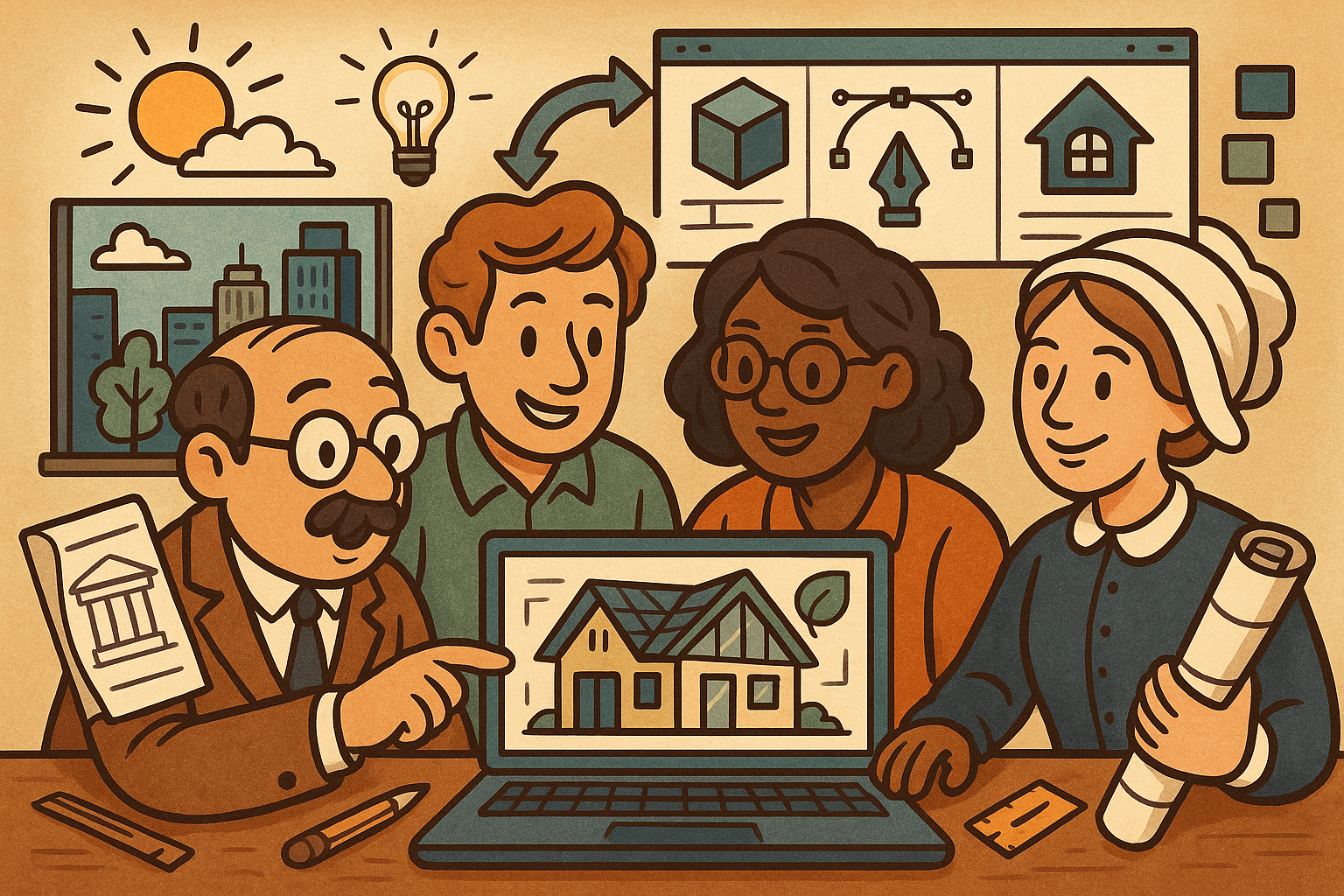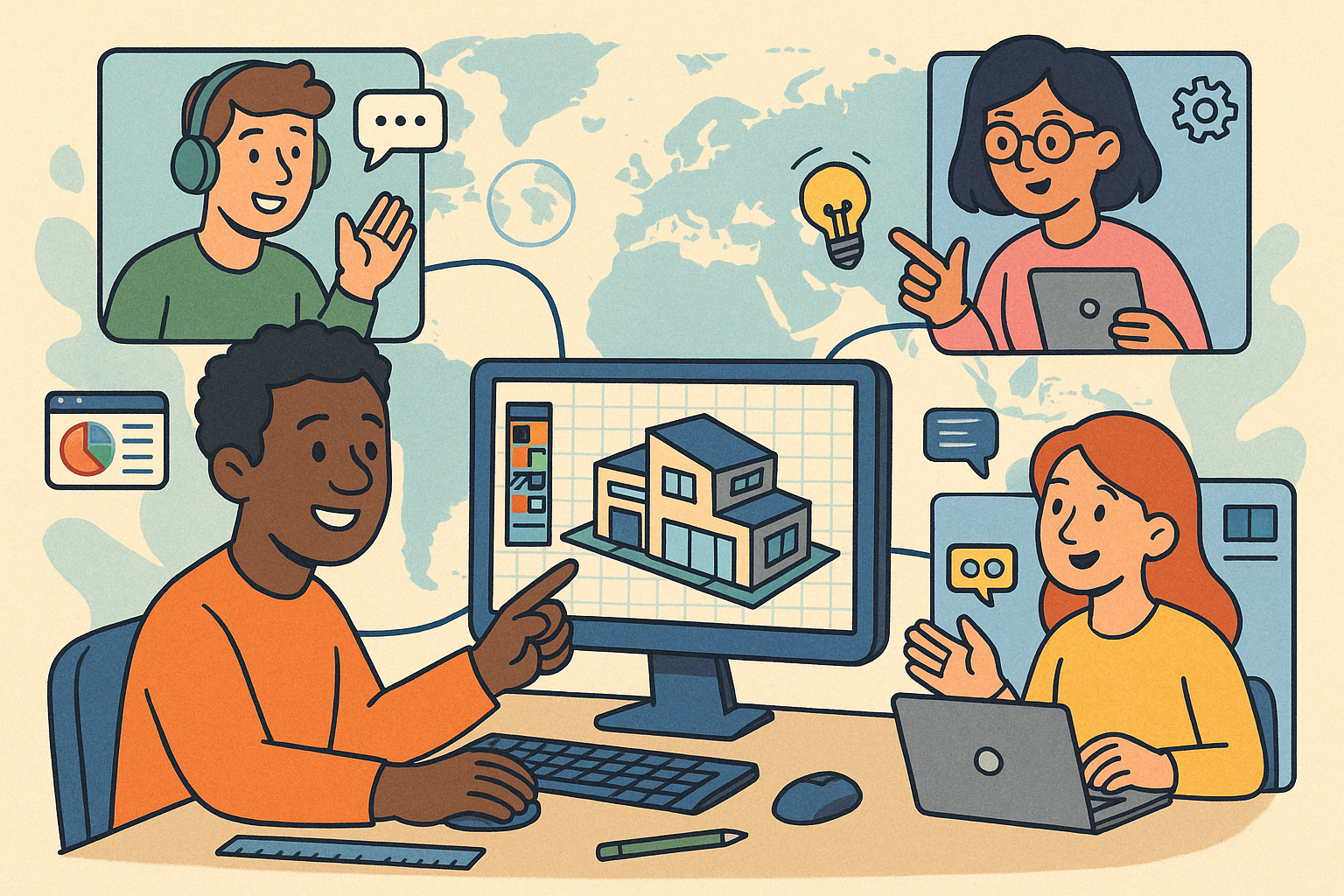Your Cart is Empty
Customer Testimonials
-
"Great customer service. The folks at Novedge were super helpful in navigating a somewhat complicated order including software upgrades and serial numbers in various stages of inactivity. They were friendly and helpful throughout the process.."
Ruben Ruckmark
"Quick & very helpful. We have been using Novedge for years and are very happy with their quick service when we need to make a purchase and excellent support resolving any issues."
Will Woodson
"Scott is the best. He reminds me about subscriptions dates, guides me in the correct direction for updates. He always responds promptly to me. He is literally the reason I continue to work with Novedge and will do so in the future."
Edward Mchugh
"Calvin Lok is “the man”. After my purchase of Sketchup 2021, he called me and provided step-by-step instructions to ease me through difficulties I was having with the setup of my new software."
Mike Borzage
Design Software History: Historical Innovations in Design Software: Paving the Path to Sustainable Architecture Through Technology and Collaboration
October 24, 2025 13 min read


Historical Context and Early Innovations – The Emergence of Sustainable Architecture as a Design Movement
The history of sustainable architecture is deeply intertwined with the evolution of design software that originally focused on digital drafting and early modeling. In the mid-20th century, architects began exploring the potential of design tools that were initially devised for mechanical drafting purposes. As environmental concerns gained traction alongside the industrial boom, design professionals recognized the need to integrate eco-friendly principles into architectural designs. This pioneering spirit pushed the boundaries of digital representation, resulting in the early emergence of sustainable design practices. Designers and architects started to explore innovative ways to incorporate natural light, energy conservation, and resource efficiency into their conceptual and technical drawings—long before these concepts received mainstream attention. With computing technology in its infancy, architects harnessed largely analog and rudimentary digital systems, which later evolved into the sophisticated computer-aided design (CAD) tools available today.
Historical Breakthroughs and Influences
During the early years, engineering and architecture converged around the shared ambition to blend functionality with environmental sensitivity. Several influential companies, including the early innovators like Autodesk, emerged as pioneers in digital drafting by developing systems that could compute basic geometric configurations. These technologies not only served as technical aids but also represented a cultural shift, where the responsibility for environmental stewardship began to integrate with architecture. Architects such as Buckminster Fuller and contemporaries who advocated for geodesic designs implicitly acknowledged that the structure of a building could achieve harmony with nature. Other contributions came from visionary firms that combined high-performance materials with computational design methodologies, prompting further inquiry into energy-saving concepts and efficient materials usage.
Historical Context and Early Innovations – Early Digital Drafting and Modeling Tools Paving the Way for Eco-Friendly Design
In the early days of digital design, innovative tools laid a foundational pathway for sustainable architectural practices by enabling precise computations and accurate modeling. Software systems matured from basic line-drawing programs to fully capable digital tools that allowed architects to experiment with form and function in a virtual environment. These early modeling tools provided a platform for exploring various design configurations with an eye toward environmental responsiveness. As computers became more accessible to professionals in the architecture realm, they could simulate environmental variables such as sunlight, wind direction, and thermal comfort. This evolution fostered an environment where the commitments to eco-friendly design could be tested and refined long before the physical construction of prototypes. Digital drafting systems introduced parameters and constraints that were aligned with nature-based performance practices, thereby creating a dual emphasis on aesthetics and functionality.
Tools and Techniques in Early Digital Modeling
Architects started using an array of techniques to realize sustainable design through digital mediums. Some of the key techniques included:
- Parametric design principles that relied on mathematical equations to model adaptive building responses.
- Integrative simulation environments where designers could test energy flows and light penetration.
- Use of vector-based drawing systems that set the foundation for more accurate blueprint rendering.
- Integration of environmental data into digital models, which laid the groundwork for later advances in environmental impact analysis.
Historical Context and Early Innovations – Influential Companies and Pioneers in Integrating Sustainability
As design software began to evolve, so too did the integration of sustainability into its functionalities. Pioneering companies and influential figures played a significant role in redefining the standards of architectural design with an emphasis on resource efficiency. Iconic names such as Autodesk and Graphisoft were instrumental in developing platforms that not only supported digital drawing but also offered modules for energy analysis and material performance simulations. At the same time, innovative architects like Norman Foster and Richard Rogers led the charge in incorporating sustainable paradigms into high-profile building projects, where the digital tools were used to validate performance hypotheses. This fusion of art, engineering, and environmental science propelled the convergence of sophisticated digital tools with green design strategies well ahead of widespread environmental consciousness, reflecting a forward-thinking alignment of technology and ethics.
Pioneering Contributions and Industry Transformation
The measurable successes of early integrations sparked a transformative period in architecture. Industry pioneers utilized design software in a manner that extended beyond mere aesthetics. Among the notable influences were:
- Innovative material analysis systems that introduced the concept of lifecycle evaluation into early design phases.
- Energy modeling modules that provided architects with data to predict and improve building performance.
- Rapid prototyping methodologies that allowed iterative design alterations, keeping sustainability in constant focus.
- Collaborative platforms that enabled cross-functional expertise to merge digital drafting with empirical environmental research.
Technological Milestones and Industry Shifts – The Evolution from Basic CAD Systems to Energy-Efficient BIM and Simulation Tools
The progression from basic computer-aided design (CAD) systems to comprehensive Building Information Modeling (BIM) and simulation tools marked a significant milestone in sustainable architecture. Early CAD systems, while revolutionary, were primarily focused on two-dimensional drafting techniques; however, they soon evolved into robust three-dimensional modeling platforms capable of addressing complex design challenges. This evolution was largely driven by a need to integrate energy-efficient BIM along with performance analysis functions that could capture environmental impacts. The evolution has witnessed a paradigm shift, where detailed digital replicas of buildings now encompass not just physical attributes but also energy dynamics, material durability, and environmental footprint data. These software advancements enabled precise calculations of thermal loads, natural light distribution, and moisture dynamics, thereby informing important decisions during the design process. The progression fostered a digital ecosystem where every element of the design was scrutinized to maximize energy efficiency and material sustainability.
Key Innovations in the Transition to BIM Platforms
This transformative period in the industry was characterized by several groundbreaking innovations:
- Transition from simple geometric representations to fully parameterized 3D models.
- Integration of simulation modules that allowed for the analysis of environmental variables such as energy consumption and carbon emissions.
- Real-time collaborative platforms that merged inputs from architects, engineers, and environmental consultants.
- Advancements in algorithms that optimized building form and structure for maximum efficiency and sustainability.
- Adoption of cloud-based storage systems which enabled sharing and updating enormous datasets crucial for effective BIM integration.
Technological Milestones and Industry Shifts – Key Innovations in Algorithms, Geometric Modeling, and Material Analysis
The integration of advanced algorithms, specialized geometric modeling techniques, and sophisticated material analysis systems has been pivotal in driving the field of sustainable architecture forward. Designers and engineers have increasingly turned to predictive models and simulation tools that integrate computational fluid dynamics, solar exposure algorithms, and thermal performance analyses to achieve structural efficiency and environmental harmony. The focus on precision optimization has demanded the development of algorithms that not only model form but predict building performance throughout the design life cycle. These innovations have made it possible to simulate how different materials respond under varying environmental conditions, enabling architects to tailor their designs to specific climatic challenges. The interplay of robust mathematical modeling with aesthetically driven design has redefined how architects approach the creation of eco-friendly buildings. The rapid technological progress enabled by these methods is transforming traditional design philosophies into a new era characterized by environmental responsiveness and proactive energy management.
Breakthrough Technologies and Their Contributions
Several breakthrough technologies have played an essential role in this transformation:
- Algorithmic optimization tools that facilitate the balancing of form and function with environmental constraints.
- Geometric modeling platforms that offer an intuitive approach for complex building geometries while accommodating environmental simulation data.
- Material analysis systems that provide comprehensive insights into the performance, durability, and environmental footprint of various building materials.
- Integration of simulation techniques that allow designers to virtually test multiple alternatives before finalizing a design.
- Development of data-intensive tools that merge design and engineering inputs into a coherent, performance-based model.
Technological Milestones and Industry Shifts – The Role of Early Digital Tools in Pioneering Sustainable Projects
Although explicit case studies are not included here, the legacy of early digital tools in pioneering sustainable projects is well-documented through industry milestones and technological narratives. The application of innovative digital drafting and simulation software by architects has long redefined project parameters and reoriented the priorities of building design. The incorporation of sustainable design software allowed early architects to reconcile environmental challenges with creative aspirations, thereby demonstrating that technological innovation and ecological responsibilities are not mutually exclusive but rather symbiotic. These tools were used to model complex energy flows, simulate daylight penetration, and analyze structural performance under environmental loads. The adoption of these technologies facilitated the design of buildings that were not only visually appealing but also sensitive to their ecological context. By reengineering the digital design process, professionals created structures that effectively balanced aesthetic form, technical efficiency, and environmental sustainability.
Digital Transformation in Early Sustainable Projects
The transformative impact of these early tools is evident from several key areas:
- Enhancement of design accuracy through the integration of environmental data into digital models.
- Development of performance-driven designs, which embrace a holistic approach featuring energy conservation techniques.
- Emergence of digitally integrated collaborative workflows that merged engineering, architecture, and environmental science seamlessly.
- Use of iterative modeling processes that continually refined building designs based on energy simulation feedback.
- Incorporation of new materials and construction techniques driven by digital analysis and sustainability requirements.
Impact on Modern Sustainable Architecture Practices – Integration of Software with Environmental Impact Analysis and Resource Optimization
In today’s arena of sustainable architecture, modern design software has transcended the boundaries of mere drafting tools to become comprehensive platforms that integrate environmental impact analysis seamlessly with resource optimization. Architects now leverage digital tools capable of simulating not just structural integrity and aesthetics, but also the environmental performance of a building. This integration is crucial in assessing factors such as carbon emissions, thermal performance, and resource conservation. Software suites today are equipped with real-time simulation capabilities that empower design teams to make informed, data-backed choices at various stages of the design process. These decisions range from the selection of building materials with low environmental impacts to the deployment of building systems optimized for energy efficiency. The incorporation of digital twin technologies into sustainable architecture practice has further enhanced the capabilities of these software systems. Digital twins – virtual replicas of physical structures – are used to monitor building performance in real-time, allowing architects and engineers to dynamically adjust parameters and optimize resource usage as conditions fluctuate.
Modern Software Integration Techniques and Their Impacts
Several techniques underscore the modern integration of environmental analysis within design platforms:
- Real-time data analytics for tracking energy consumption and predicting performance during various operational scenarios.
- Simulation modules integrated within BIM platforms for predicting how different environmental conditions will affect building performance.
- Resource optimization tools that assess the lifecycle performance of building materials, ensuring that resource use is minimized throughout construction and operational stages.
- Cloud-based data repositories that allow for the rapid sharing and updating of environmental performance metrics among interdisciplinary teams.
- Interactive visualizations that provide stakeholders with a clear picture of the projected environmental impacts, thereby fostering transparency and collaboration.
Impact on Modern Sustainable Architecture Practices – Enhancing Energy Efficiency with Real-Time Rendering, Simulation, and Digital Twin Technologies
Today’s sustainable architecture practices are characterized by the profound influence of real-time rendering, advanced simulation, and digital twin technologies that maximize energy efficiency. The advent of these sophisticated tools has allowed architects and engineers to visualize and simulate the environmental performance of a structure long before it is built. Real-time rendering provides high-fidelity, immersive visualizations, letting stakeholders virtually experience building designs and evaluate potential impacts on energy performance through immediate feedback loops. Simulation tools have advanced to incorporate complex algorithms that assess thermal performance, airflow dynamics, and daylight penetration in real time. Meanwhile, digital twin technologies offer the power to create a live, interactive model of a building that evolves with changes in its environment, facilitating ongoing adjustments that improve energy performance. As a result, design teams are in a superior position to predict issues, anticipate performance gaps, and implement design refinements that lead to highly optimized, environmentally responsible structures.
Technological Synergies Driving Energy Efficiency
A number of key technological synergies illustrate how these modern tools work together:
- Real-time rendering engines that enable instantaneous visual feedback during design modifications.
- Advanced simulation modules that utilize computational fluid dynamics to accurately forecast energy use and thermal performance.
- Digital twin platforms that bridge the gap between virtual models and physical buildings, creating opportunities for ongoing energy optimization and performance monitoring.
- Integration of cloud-based data and sensor inputs that allow for continuous performance analysis, even post-construction.
- Collaborative digital environments that enable cross-disciplinary teams to share insights and iteratively refine building designs based on real-life performance data.
Impact on Modern Sustainable Architecture Practices – The Role of Interdisciplinary Collaboration and Cloud-Based Systems
Another defining factor in modern sustainable architecture is the advent of interdisciplinary collaboration tools integrated with cloud-based systems. These innovative solutions have bridged gaps between architects, engineers, environmental scientists, and construction experts, all of whom contribute to the multi-dimensional challenges posed by modern building projects. The collaboration enabled by cloud-based platforms ensures that all stakeholders work with the same high-resolution datasets, comprehensive simulations, and real-time feedback. As a result, decisions made during the design, construction, and operational phases are informed by a synergy of diverse expertise. This unified approach minimizes errors, fosters innovation, and facilitates rapid adjustments when project scopes or environmental conditions shift. Such collaborative digital ecosystems have been particularly valuable in achieving and exceeding sustainability targets, as they help ensure that every aspect of a building’s design and operation is optimized for minimal environmental impact.
Benefits of a Cloud-Enabled Collaborative Approach
The benefits of employing cloud-based collaboration in sustainable projects are manifold:
- Unified data environments that allow multiple stakeholders to access, modify, and update design models concurrently.
- Enhanced communication channels that reduce delays and guarantee that all team members are informed of the latest design iterations.
- Centralized performance dashboards that provide real-time insights into energy consumption, resource utilization, and environmental impacts.
- Flexibility in integrating third-party analysis tools and simulation modules, making it easier to incorporate diverse data sets into decision-making.
- Scalability that allows for the handling of increasingly complex models as projects grow in scale and ambition.
Conclusion – Recap of the Historical Evolution and Technological Advances in Sustainable Architectural Design
The evolution of sustainable architecture has been powered by the relentless pursuit of integrating advanced design software with environmental imperatives and resource optimization strategies. From the initial digital drafting and modeling tools that laid the groundwork for eco-friendly design to the sophisticated BIM platforms and real-time simulation technologies that define modern practice, each technological milestone has contributed significantly to a transformative shift in the architectural paradigm. Early innovations drove a cultural and technical revolution that saw design software evolve from simple drafting utilities into comprehensive ecosystems enabling energy-efficient BIM and digital twin technologies. Such evolution reflects not only the increasing complexity of design challenges in the face of urgent ecological needs, but also the persistent drive among industry pioneers and companies alike towards environmentally responsible innovation.
Reflection on Past Achievements and Their Lasting Impacts
The journey toward achieving sustainable architecture has been characterized by collaborative ingenuity and the relentless refinement of computational methods. Influential companies and visionary architects played critical roles in establishing early design methodologies that embraced sustainability. The introduction of integrative digital models, advanced algorithms, and cloud-based collaborative environments has facilitated the efficient merging of design aesthetics with environmental performance standards. The cumulative effect of these developments is a robust foundation on which today’s architects build, continually pushing the boundaries of what is possible while remaining mindful of our environmental responsibilities. By reflecting on past achievements, it becomes evident that every leap in design software and computational analysis has contributed to a future that balances innovation with ecological stewardship, ensuring that resources are used judiciously and sustainably.
Conclusion – Final Thoughts on Potential Future Trends and the Continued Integration of Sustainability in Design Software Practices
Looking toward the future, the convergence of sustainability and design software promises even greater innovations that will redefine the built environment. The rapid adoption of cloud-based platforms, real-time performance monitoring, and artificial intelligence in simulation tools points toward a future where digital models not only predict but also autonomously adapt to changing environmental conditions. Future trends are poised to foster improvements in material sciences, algorithmic optimizations, and data analytics, thus further integrating holistic environmental impact assessments directly into the design process. As software tools continue to evolve, architects and engineers will harness these innovations to create smarter, more resilient, and more sustainable building solutions that anticipate and mitigate environmental challenges. The fusion of inter-disciplinary collaboration, cutting-edge simulation, and digital twin technologies heralds a new era in sustainable architectural practices, where design decisions are as driven by data and performance as they are by creativity and vision.
Anticipating a Sustainable and Digitally Integrated Future
In summary, the historical evolution of design software for sustainable architecture is a testament to the power of technological innovation meeting environmental stewardship. The journey from rudimentary digital drafting to the modern suite of performance-driven design tools has been marked by seminal advances that have not only enhanced the capabilities of architects and engineers but have also redefined the way we think about our built environment. Looking forward, continuous integration of sustainability into design practices will undoubtedly yield transformative projects that balance artistic brilliance with ecological responsibility. As environmental challenges intensify, the role of intelligent design software becomes even more crucial, fostering a creative and scientifically rigorous approach to building for the evolving demands of our global society.
Also in Design News

Advancing Virtual Collaboration: Redefining Global Design Teams with Digital Innovation
October 24, 2025 12 min read
Read More
Cinema 4D Tip: Mastering the Timeline for Enhanced Animation Precision in Cinema 4D
October 24, 2025 3 min read
Read More
Bluebeam Tip: Maximize Document Security and Consistency with Bluebeam Revu's Flatten Tool
October 24, 2025 2 min read
Read MoreSubscribe
Sign up to get the latest on sales, new releases and more …


